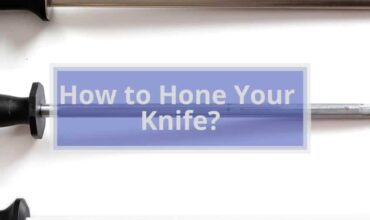Did you invest in a high-quality knife block set that turned dull and you don’t want to spend more money on an electric sharpener or a manual one? It happens all the time!
That’s why we gathered the best and most functional sharpening methods that depend only on your household or everyday items.
Some of these methods are tricky! they seem easy, but if used wrong, they can leave a damaged knife behind! so make sure you read the following lines carefully.
Method #1. Sharpening With a Ceramic Mug

The first and easiest sharpening method is using your ceramic coffee cup as a customized knife sharpener. Most cups are structured with a polished edge surface, With a rough circular bottom that prevents the cup from slippering.
This bottom can be an adaptable sharpener tool. and its sharpening grit varies between coarse, medium, and finer grit, according to your kitchen knife or pocket knife. Here is how to use a ceramic mug to sharpen your blade edge.
Steps
- Choose an old, designed mug that has a rough edge bottom.
- Place a piece of cloth or a cutting board on your working station. And put the cup upside down with the rough bottom facing you.
- Adjust your blade at 10 degree angle against the rough bottom.
- Make sure that you maintain a constant angle. Slide the blade’s entire length across the bottom of the cup.
- Turn the knife and repeat.
Note! You can use any ceramic plate or bowl instead of the mug! they will also achieve the goal of this sharpening method.
Read more, Best Fruit Knives Review
Method #2. Sharpening Using a Nail File
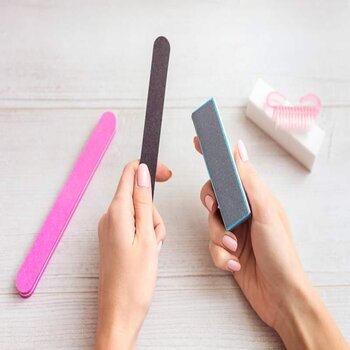
This might sound crazy, but trust me, it works! Thanks to their diamond stone rough surface structure and their flat surface similar to the standard actual sharpening stone. a nail file will sharpen your knife’s blade.
This hack can be convenient when you have nothing else to sharpen your pocket knife blade on any outdoor activities. but it isn’t gonna work with your survival knife with a serrated blade.
Steps
- Use a flat rock or a steady surface as a supporting object. then place the nail file facing upwards with the coarser grits facing you.
- Adjust your knife’s blade edge angle at 10 degrees against the nail file. Directing the sharp edge to the opposite side of your body.
- Hang on the knife in your dominant hand. while securing the file with the other hand in place. And start stroking the knife’s edge away from you.
- Maintain the same proper edge angle of sharpening. And ensure that you stroke the entire length of the blunt edge.
- Spin the knife on the other side and repeat.
Method #3. Sharpen Your Knives Using Another Knife’s Spine
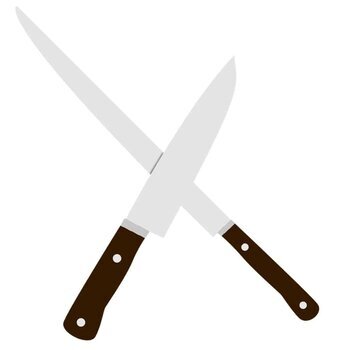
This method is like hitting two birds with one stone when you have two dull knives. and have no honing rod, manual knife sharpener, or electric knife sharpener. you can use both knives to sharpen each other!
But you need to know the right ways to use this technique, otherwise, you will end up with two damaged knives.
The proper way to do so is by using the back of the second knife blade to sharpen the knife-edge of the first one. Here are the two possible ways for this technique.
Also read , Forged Knives vs. Stamped Knives: What’s the Difference?
The First Way
Steps
- With your left hand, hold the blunt knife that needs sharpening. While in the other hand, hold the knife that you will use for sharpening.
- Position both knives in a way that their blades face your right.
- Adjust the knife angle you are holding in your right hand at a 20-degree angle against the first knife.
- Move the blade of the first sharper knife away from your body with a stroking movement. Maintaining the same angle during the sharpening.
- Turn the knife on the other side. And repeat step 4.
The Second Way
Steps
- With your right hand, grasp the knife that you need to sharpen. While in your left hand, hold the knife that you will use as a sharpener.
- Position the blade of the knife you are holding in your left hand downwards.
- Adjust the knife’s angle you are holding in your right hand at 10 degrees against the back of the knife you are holding in your left hand. With the blade facing opposite to you.
- With a smooth motion, move the knife to stroke the entire length of the blade apart from you. Maintain the same angle of sharpening throughout the entire sharpening.
- Turn the knife to the other side. And repeat step 4.
- Make sure that you carry out the same number of strokes. repeat until you reach the sharpness you need.
Method #4. Use a Flat Rock
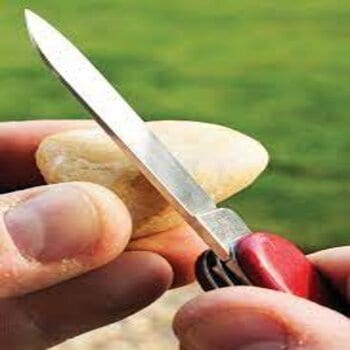
This sharpening method is ideal for hunters and those who use their pocket knife or survival knife most of the time outdoors.
The key requirement for this technique to work is selecting a smooth, flat, and porous rock to use. After that, lubricate it with water. just like a regular whetstone sharpener.
Steps
- Take a slightly flat, smooth river rock and wet it down. Even if it is clean, add some water to it to act as lubricating moisture for the abrasive stone.
- Turn the knife’s blade so that it is pointing in the opposite direction as you. Set the sharpening angle at 10 degrees and position it on the stone’s surface.
- Use a smooth motion, stroke the knife in the opposite direction from you. Ensure that you cover the entire length of the blade. Then, turn the blade and begin pushing it towards you to sharpen the opposite side.
Method #5. Sharpen Knives Using a Car Window
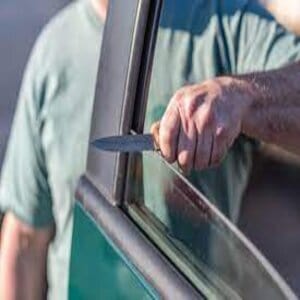
A car window edge is a very successful tool when you are on a road trip. Since the window’s rough edges are not brushed like the remainder of the window, then when you slide the dull blade edge against the window. It will act as a sharpening rod.
Steps
- Position your dull blade at a 10-degree angle on the rough side of the window’s edge.
- Using smooth motions, stroke through the opening, where the window will serve as a honing steel.
- Ensure that you stroke the entire length of the dull edge.
- Move the knife to the opposite side of the blade and begin stroking.
- Keep the same-degree angle edge. And continue repeating steps 3 and 4 on both edges until you reach the needed sharpening blade.
#Method 6. Use a Slate
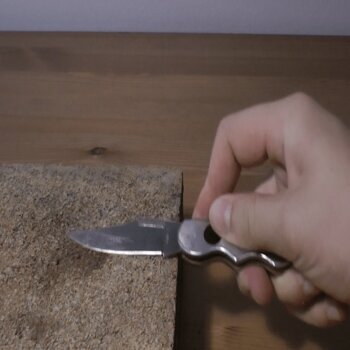
If you don’t have a whetstone sharpener to sharpen your western knives or Japanese knives, a slate will get the job done.
Slates are rough enough to permit effective sharpening but not too rough. Find a flat slate that is clean and a little rough (pieces of slate that do not have any special decorations on it).
Steps
- Find the proper slate piece and lubricate it with some water.
- Adjust the edge sharpening angle at 10 degrees against the smooth surface of the slate. Ensuring that the blade angle faces opposite to you.
- Pull the knife in the other way from you in a smooth motion against the slate. Maintaining the same angle edge between sharpenings for the entire motion.
- Make sure that you cover the entire blade length of the dull blade.
- Flip the knife on the other side. Then repeat the entire smooth motion again.
- Make sure that you stroke away equal metal shavings on both sides. Repeat until you reach the sharpness you want.
Also check , What Are The Different Types of Kitchen knives and Their Uses?
Method #7. Use a Broken Glass Bottle

The point is that a broken edge of glass bottles is not refined. If you want to sharpen your blade, unpolished slabs of glass are a good option.
The edge of glass bottles can be cut cleanly using a variety of techniques. You can do this with plate glass or a glass clipper.
Soak some string in acetone, wrap it around the part of the bottle you want. Then light it on fire for about 30 seconds, and then immerse the entire bottle in cold water.
Because both use rough glass, the sharpening technique is the same as for the car window glass.
Steps
- Find or cut a broken glass bottle. To get unbrushed edges.
- Adjust your knife’s edge at 10 degrees against the bottle top.
- In a smooth motion. Covering the entire length of the blade and stroke opposite to you.
- Turn your knife and repeat the same for the other side.
- Repeat in a smooth motion with the same degree angle of sharpening. Making sure that you stroke both sides equally until you reach the sharpness you want.
Method #8. Use a Sandpaper

Sandpaper is used as a homemade sharpening stone. Because the grit size’s roughness is similar to that of a sharpening stone.
If you do not have a sharpening steel in your high end kitchen knife block. This sharpening method is a good short-term solution. especially for your steel knives.
It would be best if you fixed the sandpaper on a piece of wood. to make it more like a customized sharpening stone, ranging from coarse to finer grit.
Steps
- Use a piece of a wooden block, fold your sandpaper in a rectangular shape. Then fix it on the block, leaving some space between the sandpaper sharpener and the block.
- Place your custom-built knife sharpening tool on a flat and stable surface. Limiting any chances of injuries or hurting your knees.
- Adjust your knife’s blade at a 15- to 20-degree angle against the sandpaper block. The knife’s blade facing opposite to your body.
- Hold the knife in your dominant hand and the sandpaper block in the other hand.
- Strok while maintaining the same sharpening edge angle. And ensure that you are covering the entire length of the blade.
- Turn your knife on the side and start stroking using the same technique but pull the blade towards you.
Method #9. Sharpening With a Shovel

In this case, we use the thickened edge of the shovel’s blade as a honing rod. In fact, a stainless steel shovel is better than an aluminum one. However, a titanium shovel would be the best option. Because of its tough razor-sharp materials.
Steps
- Hold the shovel vertically with your left hand. with the blade aligned at the bottom
- Hold the knife with the dull blade in your dominant hand. And adjust the sharpening angle edge at 10 degrees.
- Position the not sharp blade facing opposite to you. And Against the thick edge of the shovel.
- Start stroking against the shovel’s edge in a smooth motion opposite to you. Making sure that you cover the entire length of the blade. And maintaining the same edge sharpening angle.
- Turn the knife on the other side. And repeat step 4 but pull the blade towards you.
- Repeat until you reach the wanted sharpness.



